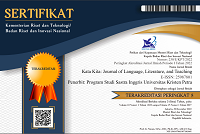Magnanimity: A Screenplay Exploring the Unconditional Forgiveness
(1) Petra Christian University
(*) Corresponding Author
Abstract
This creative thesis focuses on unconditional forgiveness, exploring the question of how a son can really hate his father. The first theory, Parental Alienation Syndrome, answers how a child can hate one parent because of the insult from the other parent. The child affected by Parental Alienation Syndrome has eight distinct symptoms. Furthermore, this creative thesis wants to explore how the son can forgive his father without the father’s repentance. Employing the Process Model of Forgiveness, the thesis shows the step-by-step journey of forgiveness without any repentance. Both theories will be applied in the creative work, a screenplay. The screenplay is about a victim of Parental Alienation Syndrome haunted by his hatred of his father ever since his parents' separation. The protagonist experiences the three symptoms of Parental Alienation Syndrome. Moreover, he will go through each stage of the Process Model of Forgiveness until achieving reconciliation with his father.
Keywords
Full Text:
PDFReferences
Baker, A. J., & Eichler, A. (2016). The linkage between parental alienation behaviors and child alienation. Journal of divorce & remarriage, 57(7), 475-484. https://doi.org/10.1080/10502556.2016.1220285
Dobkin, D. (Director). (2014). The judge [Film]. Warner Bros., Warner Bros. Pictures.
Everett L. Worthington, J. (2013). Forgiveness and reconciliation: Theory and application. Routledge.
Fathoni, A. F., Renata, P., Syamsuddin, D., & Mahardhika, S. (2021). Application of physiognomy for comic character development in “Menjelajah negeri rempah” comic. Humaniora, 12(2). https://doi.org/10.21512/humaniora.v12i2.6862
Field, S. (2009). The Screenwriter's problem solver: How to recognize, identify, and define screenwriting problems. Delta.
Freedman, S., & Enright, R. D. (2019). A review of the empirical research using Enright’s process model of interpersonal forgiveness. In Worthington Jr., E. L. Editor (Eds). Handbook of forgiveness, (2nd ed.,pp. 266-276.) Routledge/Taylor & Francis Group. https://doi.org/10.4324/9781351123341-25
Giannini, H. C. (2017). Hope as grounds for forgiveness. Journal of Religious Ethics, 45(1), 58-82. https://doi.org/10.1111/jore.12168
Ihsanuddin. (2022, March 7). Cerita ibu Ade Sara temui pembunuh anaknya di penjara, "Awalnya kami selalu gagal" [The story of Ade Sara who meets with her daughter’s killer in prison, “At first we always fail”]. KOMPAS.com. https://megapolitan.kompas.com/read/2022/03/07/09230091/cerita-ibu-ade-sara-temui-pembunuh-anaknya-di-penjara-awalnya-kami-selalu?page=all
Ingersoll-Dayton, B., Campbell, R., & Ha, J. (2008). Enhancing forgiveness: A group intervention for the elderly. Journal of Gerontological Social Work, 52(1), 2-16. https://doi.org/10.1080/01634370802561901
Jenkins, J. B. (2021, September 14). 5 Types of conflict to use for memorable stories. Jerry Jenkins | Proven writing tips. https://jerryjenkins.com/types-of-conflict/
Kellner, M. A. (2022, August 23). ‘Left behind’ author Jenkins banks on power of story for new Christian thriller. The Washington Times. https://www.washingtontimes.com/news/2022/aug/23/jerry-jenkins-left-behind-author-banks-power-story/
Klatt, J. S., & Enright, R. D. (2011). Initial validation of the unfolding forgiveness process in a natural environment. Counseling and Values, 56(1-2), 25-42. https://doi.org/10.1002/j.2161-007x.2011.tb01029.x
Kogonada (Director). (2017). Columbus [Film]. Depth of Field Nonetheless Productions Superlative Films.
Levy, D. L., & Sauber, S. R. (2012). Review of "The parental alienation syndrome," by Richard A. Gardner. The American Journal of Family Therapy, 40(4), (pp. 364-367). https://doi.org/10.1080/01926187.2011.627315
Miller, E. D. (2012). Why the father wound matters: Consequences for male mental health and the father-son relationship. Child Abuse Review, 22(3), 194-208. https://doi.org/10.1002/car.2219
Myers, S. (2022). The protagonist's journey: An introduction to character-driven screenwriting and storytelling. Palgrave Macmillan.
O’Donohue, W., Benuto, L. T., & Bennett, N. (2016). Examining the validity of parental alienation syndrome. Journal of Child Custody, 13(2-3), 113-125. https://doi.org/10.1080/15379418.2016.1217758
Pease, B. (2000). Beyond the father wound: Memory-work and the deconstruction of the father-son relationship. Australian and New Zealand Journal of Family Therapy, 21(1), 9-15. https://doi.org/10.1002/j.1467-8438.2000.tb00405.x
Penfold, P. S. (2008a, November 1). Adult children of parental alienation syndrome: Breaking the ties that bind. PubMed Central (PMC). https://www.ncbi.nlm.nih.gov/pmc/articles/PMC2583923/
Reich, J. (2017). Exploring movie construction and production: What's so exciting about movies? Open SUNY Textbooks.
Robson, P. W. (2019). Developments in revenge, justice and rape in the cinema. International Journal for the Semiotics of Law - Revue internationale de Sémiotique juridique, 34(1), 69-88. https://doi.org/10.1007/s11196-019-09614-7
Astro Shaw. Selbo, J. (2014). Film genre for the screenwriter. Routledge.
Siracusano, A., Barone, Y., Lisi, G., & Niolu, C. (2015). Parental alienation syndrome or alienating parental relational behaviour disorder: A critical overview. Journal of Psychopathology, 21(3), 231-238. https://old.jpsychopathol.it/wp-content/uploads/2015/12/03_Art_ORIGINALE_Siracusano1.pdf
Smith, H. (2016). Parental alienation syndrome: fact or fiction? the problem with its use in child custody cases. U. Mass. Law review, 11(1), 64-99. https://scholarship.law.umassd.edu/umlr/vol11/iss1/5
Swinburne, R. (2019). Stump on forgiveness. Faith and philosophy, 36(4), 512-521. https://doi.org/10.5840/faithphil20191119130
Tomaric, J. (2011). Filmmaking: Direct your movie from script to screen using proven Hollywood techniques. Taylor & Francis.
Turim, M. (2013). Flashbacks in film: Memory & history. Routledge.
Washington, D. (Director). (2016). Fences [Film]. Paramount Pictures.
Yamin, M. (2018). Dari 574 kasus, 80% pembunuhan bermotif dendam dan sakit hati [From 574 cases, 80% of the murder cases are motivated by revenge and broken hearts]. SINDOnews.com.
https://nasional.sindonews.com/berita/1356879/13/dari-574-kasus-80-pembunuhan-bermotif-dendam-dan-sakit-hati
DOI: https://doi.org/10.9744/katakita.12.1.72-79
Refbacks
- There are currently no refbacks.
Supported by:
Indexed in:
Tools:
Stats (installed since 17 December 2018)
View My Stats













